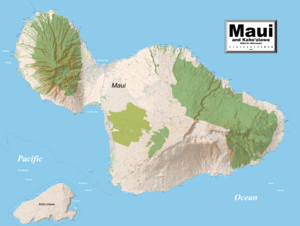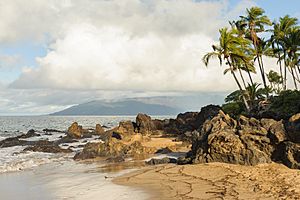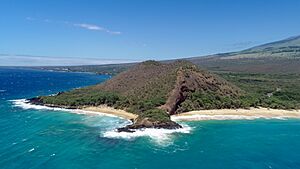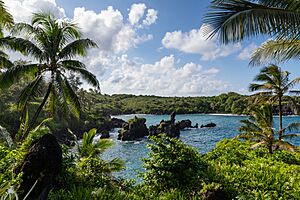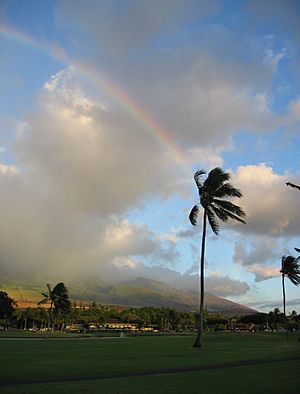Maui facts for kids
|
Nickname: The Valley Isle
|
|
|---|---|

Landsat satellite image of Maui. The small island to the southwest is Kahoʻolawe.
|
|
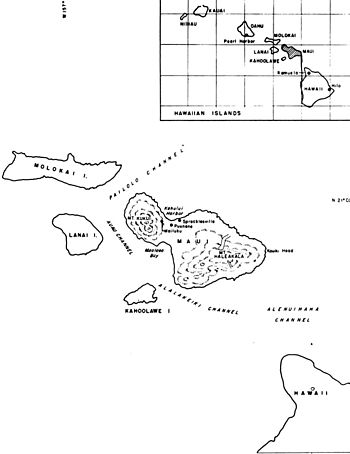
Small-scale map of the island and location in the state of Hawaii
|
|
| Geography | |
| Location | 20°48′N 156°18′W / 20.800°N 156.300°W |
| Area | 727.2 sq mi (1,883 km2) |
| Area rank | 2nd largest Hawaiian island |
| Highest elevation | 10,023 ft (3,055 m) |
| Highest point | Haleakalā |
| Administration | |
| Symbols | |
| Flower | Lokelani |
| Color | ʻĀkala (pink) |
| Largest settlement | Kahului |
| Demographics | |
| Demonym | Mauian |
| Population | 164,221 (2021) |
| Pop. density | 162 /sq mi (62.5 /km2) |
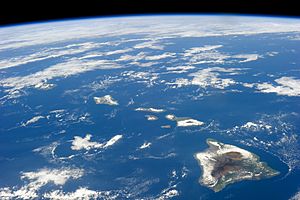
Maui is a beautiful island in the Hawaiian archipelago. It is the second-largest island in Hawaii, covering about 727 square miles (1,883 km2). Maui is also the 17th-largest island in the United States. It is one of five islands in Maui County. The other islands are Molokaʻi, Lānaʻi, Kahoʻolawe, and Molokini.
In 2020, Maui had over 168,000 people living there. This makes it the third most populated Hawaiian island. Kahului is the biggest town on Maui. It is the main center for business and money on the island. Wailuku is the county seat, which means it's where the local government is. Other important towns include Kīhei, Lāhainā, and areas like Makawao and Kula. Sadly, much of Lāhainā was destroyed by fire in 2023.
Maui is famous for its two large volcanoes. Haleakalā is in the southeast. The West Maui Mountains are in the northwest. A narrow strip of land, about six miles wide, connects these two volcanoes. This strip gives Maui its nickname: the "Valley Isle." Maui is a popular place for tourists. Nearly three million people visited in 2022. Many come for the beaches, resorts, and natural beauty.
Contents
What's in a Name?
Native Hawaiian stories tell us how Maui got its name. The legend says that Hawaiʻiloa, a famous navigator, discovered the Hawaiian Islands. He named this island after his son, who was named after the demigod Māui. Before this, the island was called ʻIhikapalaumaewa. Maui is also known as the "Valley Isle." This is because of the large flat land connecting its two big volcanoes.
How Maui Was Formed
Maui's mountains are volcanic cones. They are made from a dark rock called basalt. This rock flowed out as hot lava over millions of years. Some volcanoes were so close that their lava flows joined together. This created a single, larger island. Maui is like a "volcanic doublet." It formed from two shield volcanoes that connected to make its central valley.

The older volcano is in the west. It has worn down a lot over time. This formed the West Maui Mountains. Puʻu Kukui is the highest point there, at about 5,788 feet (1,764 meters). The younger, larger volcano is Haleakalā in the east. It rises to 10,023 feet (3,055 meters) above sea level. From the seafloor to its top, it measures about 5 miles (8 km). The sides of both volcanoes have deep valleys and steep ravines. These lead down to the rocky coast. The flat land between them was formed by sand and dirt washed down from the mountains.
Haleakalā last erupted between 1480 and 1600. The lava flows from this eruption are at Cape Kīnaʻu. Haleakalā is currently sleeping, but it could erupt again one day. Maui was once part of a much larger landmass called Maui Nui. This included the islands of Lānaʻi, Kahoʻolawe, and Molokaʻi. When sea levels were lower, these islands were all connected. This happened as recently as 200,000 years ago.
Maui's Weather
Maui has a tropical climate. This means it has two seasons: a wet season and a dry season. Temperatures are warm all year round. The weather changes a lot depending on where you are on the island. This is because of the mountains and the trade winds. Trade winds are steady winds that blow from the northeast.
Maui's mountains and valleys change how the wind blows. This creates different weather in different areas. Daytime temperatures usually range from 75°F to 90°F (24°C to 32°C). Evenings are cooler, especially in the mountains. Sometimes in winter, a "Kona storm" brings rain and strong winds from the southwest. This is different from the usual trade winds.
Different Climates on Maui
Maui has many different small climates, called microclimates. Each one is unique to its location.
- Windward lowlands are on the north and northeast sides. They get moderate rain from the trade winds. Skies are often cloudy. Temperatures are mild.
- Leeward lowlands are on the south and west sides. They are drier and have higher daytime temperatures. Rain is less common here.
- Interior lowlands have mixed conditions. They can get strong afternoon showers from local heating.
- High-altitude mountain slopes on the leeward side get a lot of rain and clouds all year. It's mild but very humid.
- Lower mountain slopes on the leeward side get more rain than the lowlands. But it's less than the windward side. Temperatures are higher here.
- High mountains like Haleakalā (above 5,000 feet or 1,500 meters) get less rain. The air is very dry. It can get very cold, even below freezing, and sometimes snows.
These microclimates create different regions on Maui:
- Central Maui includes Kahului and Wailuku. It's a flat area between the two volcanoes. Kahului is usually warm and breezy. Wailuku gets more rain and is more humid.
- South Maui (Kīhei, Wailea, Makena) and West Maui (Lāhainā, Kāʻanapali, Kapalua) are on the drier, leeward side. They have higher daytime temperatures and less rain.
- The North Shore (Paia, Haiku) and East Maui (Keanae, Hāna, Kipahulu) are on the windward side. They face the trade winds and get much more rain, especially higher up.
- Upcountry Maui is on the western side of Haleakalā. Towns like Makawao, Pukalani, and Kula are here. It's usually mild during the day and cool at night. The higher you go, the cooler it gets.
How Much Rain?
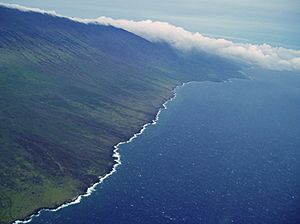
Showers are common on Maui. Most are light and short. Thunder and lightning are rare. In the lowlands, summers are drier. Leeward coastal areas get about 17-20 inches (430-510 mm) of rain each year. But on the lower windward slopes of Haleakalā, it can rain over 300 inches (7,600 mm) a year! One spot, Big Bog, gets an average of 404 inches (10,260 mm) of rain annually.
Rainfall is most likely at night or in the morning in the lowlands during summer. In winter, storms can bring rain at any time. Sometimes, there are droughts, especially in dry areas that rely on winter rains.
Maui's Nature and Animals
Maui has a large rainforest on the northeast side of Haleakalā. This forest helps collect water for that part of the island. Maui also has many coral reefs. Sadly, some have been harmed by pollution. But sea turtles, dolphins, and colorful tropical fish are still common.
Marine Life
Maui is a top spot for whale-watching in Hawaii. Many humpback whales spend their winters here. They travel about 3,500 miles (5,600 km) from Alaskan waters every autumn. From November to April, they mate and have their babies in Maui's warm waters. You can often see them in small groups. Humpback whales are an endangered species. Their numbers have been growing quickly in recent years.
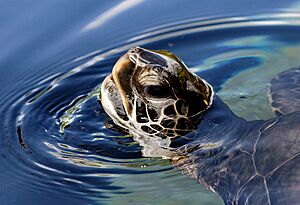
Other marine mammals include spinner, bottlenose, and spotted dolphins.
Birdlife
Maui is home to some special birds. The 'Akohekohe and the Maui parrotbill (also called Kiwikiu) are critically endangered. They live only in a special forest on Haleakalā. These birds are sensitive to mosquito-borne diseases. So, they can only live in forests above 1,500 meters (5,000 feet). Efforts are being made to protect their habitat.
Other birds found on Maui and other islands include the I'iwi, 'Apapane, Hawai'i 'Amakihi, Maui 'Alauahio, and the Nene (Hawaii's state bird). In 2024, Haleakala National Park started using a special method to reduce mosquitoes. This helps protect the birds.
Maui is also home to the Hawaiian hoary bat. This is Hawaii's only native land mammal.
Maui's Past

The first people to live on Maui were Polynesians. They came from Tahiti and the Marquesas Islands. They brought the kapu system. This was a strict set of rules that guided all parts of life. It became a key part of Hawaiian culture.
Modern Hawaiian history began in the mid-1700s. Kamehameha I, the king of Hawaiʻi Island, fought to take over Maui in 1790. He finally took control of Maui a few years later.
On November 26, 1778, explorer James Cook was the first European to see Maui. But he never landed on the island. The first European to visit Maui was French admiral Jean-François de Galaup, comte de Lapérouse. He landed at La Perouse Bay on May 29, 1786.
More Europeans came after that. They were traders, whalers, and missionaries. Missionaries from New England arrived in 1823. They settled in Lāhainā, which was the capital at the time. They changed the local culture a lot. But they also taught reading and writing. They created the 12-letter Hawaiian alphabet and started a printing press. This helped to record and save Hawaiian history and language. The first school in Lāhainā, Lahainaluna Mission School, opened in 1831 and is still open today.
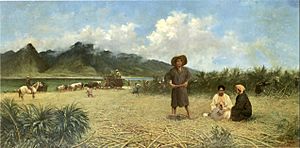
From 1843 to 1860, Lāhainā was a major center for whaling. Many whaling ships visited the harbor. But whaling declined when petroleum replaced whale oil at the end of the 1800s.
Kamehameha's family ruled until 1872. Then, other chiefs ruled, including Queen Liliʻuokalani. She was queen in 1893 when the Kingdom of Hawaii was overthrown. The Republic of Hawaii was formed a year later. The United States took over the island in 1898. Hawaii became the 50th U.S. state in 1959.
Maui played a big role in World War II. It was a place for soldiers to train, prepare for battles, and rest. At its busiest in 1943-44, over 100,000 soldiers were on Maui.
Maui Today
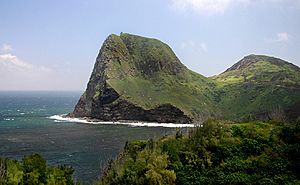
Maui grew very quickly until 2007. Many people, including retirees, moved to the island. This growth caused some problems. These included traffic, high housing costs, and concerns about water supply.
There were debates about allowing more building. Vacation rentals in neighborhoods became a big issue. Some were not allowed and were later closed. A ferry service between islands was stopped because it did not complete an environmental study.
In 2016, Maui residents convinced officials to use organic pesticides on highways. This happened after they found out that rules for certain chemicals were not followed.
Water for Maui
Maui has faced droughts in recent years. This puts pressure on its water sources. Most water for farming comes from streams in East Maui. It is moved through tunnels and ditches built by Chinese workers in the 1800s.
In 2009, a court ruled that sugar companies should take less water from four streams. This was a win for local Hawaiian groups.
Maui's Economy
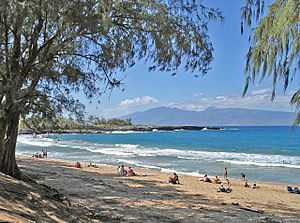
Tourism is the biggest industry on Maui. Other important areas are building, shopping, health care, and government jobs. Maui also has growing agriculture and technology industries.
Unemployment rates on Maui are usually low. However, the 2023 fires caused a rise in unemployment.
Farming on Maui
Maui's main farm products include corn, fruits, cattle, wine, and vegetables. Specific products are coffee, macadamia nuts, papaya, flowers, and fresh pineapple. In 1974, the first Hawaiian commercial winery, Tedeschi Winery (now Maui Wine), started. It first made pineapple wine.
In the past, sugar and pineapple were Maui's main farm products. But sugar production ended in 2016. Now, Haliimaile Pineapple Co. grows pineapple on old farm lands. In 2014, Maui County voted to stop genetically engineered crops. But a court stopped this rule.
In 2018, a Canadian company bought a lot of Maui's farmlands. They plan to bring these lands back to farming.
Technology and Space
Many technology companies are in the Maui Research & Technology Park in Kīhei. This park helps Hawaii's high-tech industry grow.
Maui is also important for studying space. The Haleakalā Observatory is on top of Haleakalā volcano. It is a great place to watch satellites, missiles, and stars. This is because of its high elevation, dry climate, and clear skies.
Fun Things to Do on Maui
Snorkeling and Diving
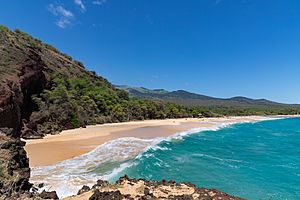
Snorkeling and diving are very popular on Maui. There are over 30 beaches and bays, plus Molokini. The best places to snorkel are on the calm south and west shores. Maui's ocean water is very clear.
Windsurfing and Surfing
Maui is famous for windsurfing. Kanaha Beach Park is a well-known spot. Windsurfing has been popular here since the 1980s.
Surfing is one of Hawaii's most popular sports. Ho'okipa Beach Park is a famous spot for both surfing and windsurfing. Other popular surfing areas include Slaughterhouse Beach, Honolua Bay, and Pe'ahi (Jaws). The north side gets big waves in winter. The south and west sides get waves in summer. Stand-up paddling is also popular across Maui.
Kitesurfing and Wing Foiling
Kitesurfing is popular, especially at Kanaha Beach Park. Wing foiling is a newer sport. It is often practiced at Kahului Harbor.
Places to Visit
The main tourist spots are Hāna and Haleakalā National Park. The Hana Highway goes along the east coast. It crosses many streams and passes black sand beaches and waterfalls. Haleakalā National Park is home to the dormant volcano Haleakalā. The Maui Ocean Center aquarium in Ma'alaea is another attraction.
Most visitors spend time at resorts in West Maui (Kāʻanapali, Kapalua) and South Maui (Kīhei, Wailea-Mākena). Cruise ships dock at Kahului Harbor. Smaller ports are at Lāhainā Harbor (currently closed) and Maʻalaea Harbor. The town of Lāhainā was a very popular place to visit until the 2023 fires. It is now closed for visitors.
Maui has won awards as the "Best Island In The World." However, some locals worry about too much building. Groups like Save Makena work to protect the rights of local people.
Getting Around Maui
The Maui Bus is a bus system that helps people travel around the island for a small fee.
Airports
Three airports serve Maui:
- Hana Airport serves eastern Maui.
- Kahului Airport in central Maui is the main airport.
- Kapalua Airport serves western Maui.
Healthcare on Maui
Maui Memorial Medical Center (MMMC) is the only main hospital in Maui County. It is in Wailuku. Kula Hospital is a smaller hospital in the rural town of Kula. Hana Health Clinic helps people in Hana with urgent medical needs. These facilities are open 24/7.
Sister Cities
Maui has special connections with cities in other countries. These are called "sister cities":
 Funchal, Madeira, Portugal
Funchal, Madeira, Portugal Arequipa, Perú
Arequipa, Perú Quezon City, Philippines, since 1970
Quezon City, Philippines, since 1970
Famous People from Maui
Many well-known people have lived on Maui or have strong ties to the island. These include:
- Alice Cooper, musician
- Clint Eastwood, actor and director
- Mick Fleetwood, musician
- Woody Harrelson, actor
- George Harrison, musician from The Beatles
- Kris Kristofferson, musician
- Charles Lindbergh, famous aviator
- Willie Nelson, musician
- Richard Pryor, comedian
- Steven Tyler, lead singer of Aerosmith
- Owen Wilson, actor
- Oprah Winfrey, talk show host
- Weird Al Yankovic, musician
|
See also
 In Spanish: Maui para niños
In Spanish: Maui para niños


